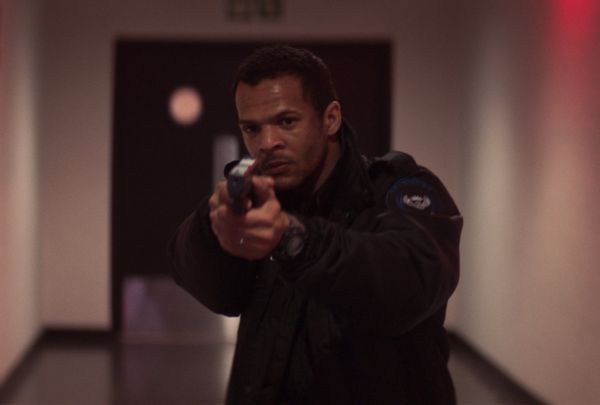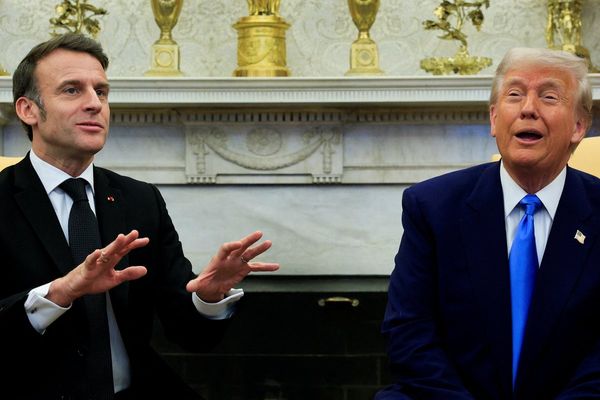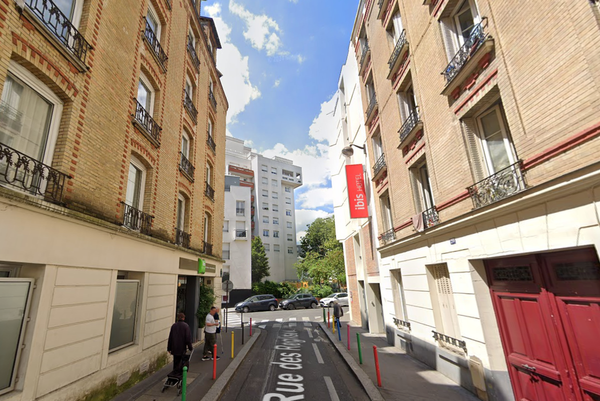
"Indemnity" is an intense, impressive South African action film written and directed by Travis Taute (his debut) that grapples with PTSD, trauma, and conspiracies. In the film, beefy firefighter Theo Abrams (Jarrid Geduld in a star-making performance) is recovering from the death of his colleagues during a rescue. Unable to work without clearance from Dr. Tunbridge (Susan Danford), a psychiatrist, and going through a rough patch in his marriage to Angela (Nicole Fortuin), Theo is at a crossroads. However, his life really gets upended when Angela is found dead and Theo is suspected of her murder.
With Detective Rene Williamson (Gail Mabalane) and her boss, General Alan Shard (Andre Jacobs) in pursuit, things quickly get complicated for Theo. As he goes on the run, bodies pile up, as does incriminating evidence. He also finds highly classified information concerning an experimental program that may lead to the future of warfare.
RELATED: A Maori action movie? Hell yes
"Indemnity" zips along with numerous chases, fight scenes, and explosions as Theo tries to uncover the truth and clear his name. Remarkably, Geduld performed all of his own stunts — including one hair-raising bit outside a 21st-floor hotel window.
Taute spoke with Salon about crafting his exciting new film, depicting trauma, and the state of South African cinema.
What can you say about the scope of a making a project like "Indemnity?" There are drone shots, action scenes, chase, explosions, fights, car accidents, and stunts. How ambitious did you get with writing, directing, and the action here?
I wanted to make an action film, and I was very fortunate that my producers bought into that vision and that ambition. We wanted to move the needle in terms of the perception of what kinds of films can come out of South Africa. I love action as a genre, and it is notoriously expensive to produce. We haven't been afforded the opportunity to do this in the past. But we have all the capability to pull it off. So, for us, it was about striking a balance with our ambitions. There needs to be an action sequence every 10 minutes. We had to be really clever about what was realistically achievable in our budget. We made a conscious choice to keep things as contained as possible — a fight in an elevator, or in the back of police van. We knew the fire scenes would be a challenge to accomplish, so we used our resources for that. It really started with the writing. It's a man on the run story, so we are constantly moving to different locations. I wanted to make a film that had action set pieces but was grounded by character. Sometimes it was too ambitious, so I reined it in, and sometimes it was organic.
I appreciate that your film addresses PTSD and trauma for first responders. Why did you decide to explore that topical issue?
There were multiple reasons that led to this being the issue tackled in the film. I wanted this to be a love letter to the films of the '90s and '00s, which had social commentary embedded in a blockbuster. I wanted to highlight things that are important and not spoken about that often. The impetus for "Indemnity" came about a couple of years ago when I read about American soldiers returning from Afghanistan war who were having trouble reintegrating into society. I stumbled upon this one story of a veteran was home less than 24 hours. He reunited with his family and while at a local grocer, he shot the cashier and sat on the pavement and waited for the police. He had no recollection of the events and was retraumatized discovering what he had done. I thought that was such a harrowing story. It sent me down rabbit hole to investigate PTSD. I brought it home. In our country, unfortunately, we have a very high crime rate. A lot of people are suffering from trauma here. PTSD specifically is quite undiagnosed.
Looking further, at first responders — we've seen the police angle, but people don't know how much firefighters actually go through on a daily basis. If there is a car crash on the freeway, you know what the paramedics and policemen are doing, but if there are fatalities, the firefighters have to clean that up. I chatted with firefighters about their stories. I really understood that the platform to talk mental health is really not there for them to cope and survive and do the work that they do. Bringing it closer to home, I felt with men in particular — and men of color of a certain generation — there is this idea of what a man is and what a man should be. When it comes to any issues regarding mental health, there is such a terrible stigma attached to it, it gets swept under the rug. It's considered weak. This inability for men to converse in a constructive way about not being well emotionally and psychologically and being supported in that conversation. That was important to me, and powerful and why I landed on that as the issue I wanted to speak about in his film.
"Indemnity" is set in South Africa, features some Afrikaans dialogue, and Black leads. However, your film is not really about race — though that issue hangs in the background. Can you discuss that?
Race is such a big issue worldwide — especially in South Africa with our history. It's been an omnipresent theme in films that come out of South Africa. Apartheid hangs in the air in so many of our films. I specifically wanted the main character in "Indemnity" to be a person of color. I wanted to be as authentic as I could be and speak to a story that I personally understand. But also, we haven't seen an action hero, or someone represented in this way, in a South African film before. Race was about subverting expectation. How do we have race be there in the background, and feel it, but not have it be an issue or spoken about? How do we not make it the prominent, pervading thing that people take away from the plot? It was purposefully designed to remove that issue and have people sucked into what we were trying to do with the story.
Want a daily wrap-up of all the news and commentary Salon has to offer? Subscribe to our morning newsletter, Crash Course.
I was pleased your film opens with a personal story, gets a bit cloak-and-dagger, turns into an action film and ends up being a conspiracy movie. Can you talk about creating the film's tone and shifting genres?
There was a fear there might be too much. For me, I grew up loving action films, and man on the run stories. You can feel the influence of "Enemy of the State," "The Bourne Ultimatum," and political conspiracy thrillers. These are my favorite kind of films to watch. So, it was in the developing the film and escalating the stakes — dealing with trauma and one man's psychological struggle. I asked: What if it was something bigger? What if trauma can be weaponized? That made me do research. There are so many elaborate and varying techniques used to treat patients with psychological issues and taking things further. That propelled me into the political arena. I tried to make it something that could be a reality. I wanted the film to feel grounded and feel as real as possible even if it teeters on the edge of sci-fi.

One thing that is typical of the conspiracy genre is how Theo has information fall into his lap at times. I know you need some contrivances to move the story forward, but did you incorporate them?
It was all in the writing, it could easily become action with chunks of exposition explaining to the audience what is happening. It was a complicated story, and we wanted to engineer twists and turns, but not have you feel you could lose track of what was happening and why. I spent the most time on those pieces of the film where you have to tie things together and explain what is happening and why. I find that in films I watch. You do get removed if you are spoonfed everything, so you have to be careful how much information you reveal at what point and time. It has to be intriguing enough in the beginning to spur someone on a journey without giving you all the answers, so the dots can connect at the end. In the making of it, we're also limited by how many days and locations we can shoot. Your ambition as a filmmaker is to do things visually, because film is a visual language, and you don't always have that opportunity so you have to strike the balance between what you can show people and what you need to tell them.
Theo's character suffers mentally, but also physically. He is shot. He is beaten. He hangs out a window on cut glass. He gets in a car accident. He catches on fire. Can you talk about the grueling paces you put Jarrid Geduld through?
I wanted to keep each sequence fresh, so it felt like a different challenge for Theo's character, but also put him through wringer, physically. He's a very resilient character. He has been through so much trauma. For me, he was extremely strong in terms of his physical capabilities, and I wanted to show someone going through so much but not stopping or giving up. That's the fascinating thing about the human spirit — we have this insane ability to endure. He has psychological faults and setbacks, but physically, he was able to keep moving despite sustaining injury after injury.
Speaking of injury, Jarrid performed his own stunts, too!
When you think of firemen, everyone has preconceived expectation of them being big, buff guys. Jarrid is 5' 10" and he brought this soft, vulnerable energy [to his audition]. I felt immediately when I saw it — that's him. We had a team to train whoever we cast for action. But we need a performer who could do the emotions. When we knew we would be casting Jarrid, I had conversations with producers and stunt coordinators because I wanted to do everything as practical as possible.
We were lucky that Jarrid is super athletic; he used to be a gymnast. I love films when you know the actors immersed in the role doing their own stunts. It adds an extra level of cool. When I spoke to Jarrid about that, he said that's great he wanted to all his own stunts. He underwent about two months of intensive training and conditioning to get into shape. The stunt team coached Jarrid through every fight sequence. We spoke about the emotion of each sequence and where Theo is as a character and how he'd react to those environments. Jarrid went to firefighter training, so we could shoot the opening fire scene and how to handle fire, and the correct movement, so it would feel as authentic as possible. That was challenging. I never worked with those kinds of special effects, or shot a scene on that scale before.
The two most challenging sequences were the back of police van fight sequence — we were on a freeway with two characters bouncing around the vehicle, but we couldn't shoot on the freeway — and the window sequence. There weren't a lot of locations that actually provide the aesthetic I wanted for that. I wanted glass windows so there was nothing to hold onto. I wanted to induce vertigo. We had to break the sequence up into two parts. The first was him climbing out of window, the second part where he dropped and hung onto the window. We only had about a half day to shoot. Once everything was rigged, Jarrid could feel what it was like and feel safe doing these really risky stunts. That anxiety and fear of being that high up is real. I was so impressed with him, and thankful that he was willing to take this on board.
Lastly, I wanted to go back and ask about working in the South African film industry. Is there a pressure to make films that have broad appeal but also focus on South Africa?
I have always felt that we have so much to offer as a film industry. People shoot here all the time. We have this amazing topography that doubles for so much, and we have crew and equipment that is top class. But we don't get to flex our storytelling muscle that our filmmakers are very capable of. That's been the general consensus over the last 20 years. In the last five years, there has been this new wave of filmmakers breaking the norm and producing the stories.
As I said previously, our films are often about apartheid. But those aren't the only stories we have to tell. That's our history, but we have 11 different languages and so many diverse cultures and traditions. I can see us doing epic fantasy film because of history and mythology that exists here is so massive. People are starting to believe that the industry is not feasible to only make films for local audiences. So, how can you position certain elements of the film to have a broader appeal? That speaks to imbuing with universal themes, like PTSD, that folks can engage with and relate to. If you can achieve that, all you need to do is set your world and characters in a unique subculture.
With Netflix and other streamers, people are seeing films from various parts of the world. They now have the appetite for international films and films set in exotic locations and in unique subcultures. How can you capitalize on that mentality? How can you make a broad action film that tells a specific South African story that people with be able to identify with? Hopefully, we'll see different kinds of films from South Africa in the future.
"Indemnity" opens Friday, Feb. 11 in theaters and is available on VOD. Watch a trailer for it below, via YouTube.
More stories to read:







